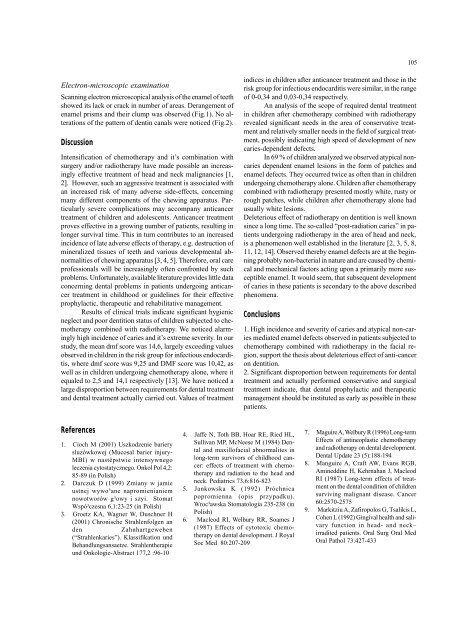Annals of Diagnostic Paediatric Pathology
Annals of Diagnostic Paediatric Pathology
Annals of Diagnostic Paediatric Pathology
Create successful ePaper yourself
Turn your PDF publications into a flip-book with our unique Google optimized e-Paper software.
105<br />
Electron-microscopic examination<br />
Scanning electron microscopical analysis <strong>of</strong> the enamel <strong>of</strong> teeth<br />
showed its lack or crack in number <strong>of</strong> areas. Derangement <strong>of</strong><br />
enamel prisms and their clump was observed (Fig.1). No alterations<br />
<strong>of</strong> the pattern <strong>of</strong> dentin canals were noticed (Fig.2).<br />
Discussion<br />
Intensification <strong>of</strong> chemotherapy and it’s combination with<br />
surgery and/or radiotherapy have made possible an increasingly<br />
effective treatment <strong>of</strong> head and neck malignancies [1,<br />
2]. However, such an aggressive treatment is associated with<br />
an increased risk <strong>of</strong> many adverse side-effects, concerning<br />
many different components <strong>of</strong> the chewing apparatus. Particularly<br />
severe complications may accompany anticancer<br />
treatment <strong>of</strong> children and adolescents. Anticancer treatment<br />
proves effective in a growing number <strong>of</strong> patients, resulting in<br />
longer survival time. This in turn contributes to an increased<br />
incidence <strong>of</strong> late adverse effects <strong>of</strong> therapy, e.g. destruction <strong>of</strong><br />
mineralized tissues <strong>of</strong> teeth and various developmental abnormalities<br />
<strong>of</strong> chewing apparatus [3, 4, 5]. Therefore, oral care<br />
pr<strong>of</strong>essionals will be increasingly <strong>of</strong>ten confronted by such<br />
problems. Unfortunately, available literature provides little data<br />
concerning dental problems in patients undergoing anticancer<br />
treatment in childhood or guidelines for their effective<br />
prophylactic, therapeutic and rehabilitative management.<br />
Results <strong>of</strong> clinical trials indicate significant hygienic<br />
neglect and poor dentition status <strong>of</strong> children subjected to chemotherapy<br />
combined with radiotherapy. We noticed alarmingly<br />
high incidence <strong>of</strong> caries and it’s extreme severity. In our<br />
study, the mean dmf score was 14,6, largely exceeding values<br />
observed in children in the risk group for infectious endocarditis,<br />
where dmf score was 9,25 and DMF score was 10,42, as<br />
well as in children undergoing chemotherapy alone, where it<br />
equaled to 2,5 and 14,1 respectively [13]. We have noticed a<br />
large disproportion between requirements for dental treatment<br />
and dental treatment actually carried out. Values <strong>of</strong> treatment<br />
indices in children after anticancer treatment and those in the<br />
risk group for infectious endocarditis were similar, in the range<br />
<strong>of</strong> 0-0,34 and 0,03-0,34 respectively.<br />
An analysis <strong>of</strong> the scope <strong>of</strong> required dental treatment<br />
in children after chemotherapy combined with radiotherapy<br />
revealed significant needs in the area <strong>of</strong> conservative treatment<br />
and relatively smaller needs in the field <strong>of</strong> surgical treatment,<br />
possibly indicating high speed <strong>of</strong> development <strong>of</strong> new<br />
caries-dependent defects.<br />
In 69 % <strong>of</strong> children analyzed we observed atypical noncaries<br />
dependent enamel lesions in the form <strong>of</strong> patches and<br />
enamel defects. They occurred twice as <strong>of</strong>ten than in children<br />
undergoing chemotherapy alone. Children after chemotherapy<br />
combined with radiotherapy presented mostly white, rusty or<br />
rough patches, while children after chemotherapy alone had<br />
usually white lesions.<br />
Deleterious effect <strong>of</strong> radiotherapy on dentition is well known<br />
since a long time. The so-called “post-radiation caries” in patients<br />
undergoing radiotherapy in the area <strong>of</strong> head and neck,<br />
is a phenomenon well established in the literature [2, 3, 5, 8,<br />
11, 12, 14]. Observed thereby enamel defects are at the beginning<br />
probably non-bacterial in nature and are caused by chemical<br />
and mechanical factors acting upon a primarily more susceptible<br />
enamel. It would seem, that subsequent development<br />
<strong>of</strong> caries in these patients is secondary to the above described<br />
phenomena.<br />
Conclusions<br />
1. High incidence and severity <strong>of</strong> caries and atypical non-caries<br />
mediated enamel defects observed in patients subjected to<br />
chemotherapy combined with radiotherapy in the facial region,<br />
support the thesis about deleterious effect <strong>of</strong> anti-cancer<br />
on dentition.<br />
2. Significant disproportion between requirements for dental<br />
treatment and actually performed conservative and surgical<br />
treatment indicate, that dental prophylactic and therapeutic<br />
management should be instituted as early as possible in these<br />
patients.<br />
References<br />
1. Cioch M (2001) Uszkodzenie bariery<br />
sluzówkowej (Mucosal barier injury-<br />
MBI) w nastêpstwie intensywnego<br />
leczenia cytostatycznego. Onkol Pol 4,2:<br />
85-89 (in Polish)<br />
2. Darczuk D (1999) Zmiany w jamie<br />
ustnej wywo³ane napromienianiem<br />
nowotworów g³owy i szyi. Stomat<br />
Wspó³czesna 6,1:23-25 (in Polish)<br />
3. Groetz KA, Wagner W, Duschner H<br />
(2001) Chronische Strahlenfolgen an<br />
den<br />
Zahnhartgeweben<br />
(“Strahlenkaries”). Klassifikation und<br />
Behandlungsansaetze. Strahlentherapie<br />
und Onkologie-Abstract 177,2 :96-10<br />
4. Jaffe N, Toth BB, Hoar RE, Ried HL,<br />
Sullivan MP, McNeese M (1984) Dental<br />
and maxill<strong>of</strong>acial abnormalites in<br />
long-term survivors <strong>of</strong> childhood cancer:<br />
effects <strong>of</strong> treatment with chemotherapy<br />
and radiation to the head and<br />
neck. Pediatrics 73,6:816-823<br />
5. Jankowska K (1992) Próchnica<br />
popromienna (opis przypadku).<br />
Wroc³awska Stomatologia 235-238 (in<br />
Polish)<br />
6. Macleod RI, Welbury RR, Soames J<br />
(1987) Effects <strong>of</strong> cytotoxic chemotherapy<br />
on dental development. J Royal<br />
Soc Med 80:207-209<br />
7. Maguire A, Welbury R (1996) Long-term<br />
Effects <strong>of</strong> antineoplastic chemotherapy<br />
and radiotherapy on dental development.<br />
Dental Update 23 (5):188-194<br />
8. Manguire A, Craft AW, Evans RGB,<br />
Amineddine H, Kehrnahan J, Macleod<br />
RI (1987) Long-term effects <strong>of</strong> treatment<br />
on the dental condition <strong>of</strong> children<br />
surviving malignant disease. Cancer<br />
60:2570-2575<br />
9. Markitziu A, Zafiropolos G, Tsalikis L,<br />
Cohen L (1992) Gingival health and salivary<br />
function in head- and neck–<br />
irradited patients. Oral Surg Oral Med<br />
Oral Pathol 73:427-433
















